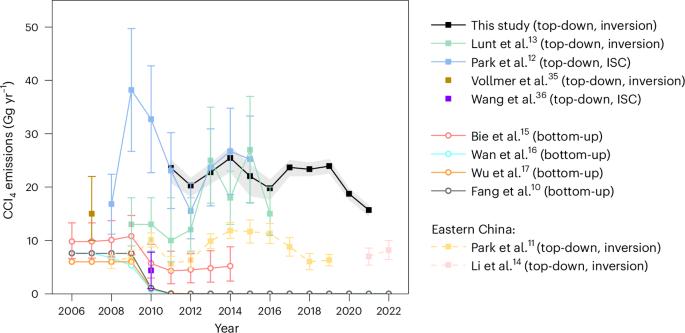Persistent emissions of ozone-depleting carbon tetrachloride from China during 2011–2021
IF 16.1
1区 地球科学
Q1 GEOSCIENCES, MULTIDISCIPLINARY
引用次数: 0
Abstract
Lingering global emissions of carbon tetrachloride (CCl4) are slowing ozone layer recovery. Estimates of global CCl4 emissions based on observed atmospheric mole fractions and inverse modelling (top down) exceed the emissions derived from known sources (bottom up) by ~30–40%. Here we derived CCl4 emissions from China for 2011–2021 using long-term atmospheric observations from a network of sites from across China and a top-down approach. Mean annual CCl4 emissions in China during 2011–2021 were between approximately 16 Gg yr−1 and 25 Gg yr−1, substantially larger than previous bottom-up inventories for China of less than 6 Gg yr−1 since 2011. Expressed in terms of ozone depletion potential (ODP)-weighted emissions, CCl4 annual emissions from China are comparable to global annual ‘unexpected’ trichlorofluoromethane (CFC-11) emissions during 2013–2018, or global total annual hydrochlorofluorocarbon emissions in 2020. The CCl4 emissions from China accounted for approximately half of the reported global total during 2011–2020, with neither showing a significant decreasing trend during this period. Substantial CCl4 emissions in China from allowed feedstock use, during the renewed production of CFC-11 between 2013 and 2018, and from by-production could close some of the emissions gap. However, ~4–15 Gg yr−1 of CCl4 emissions in China remain unexplained during 2011–2021, potentially accounting for more than half of the remaining global gap. China contributed about half of the global carbon tetrachloride (CCl4) emissions during 2011–2021, according to long-term atmospheric observations from China.


2011-2021年中国消耗臭氧层的四氯化碳的持续排放
全球持续排放的四氯化碳(CCl4)正在减缓臭氧层的恢复。基于观测到的大气摩尔分数和反向模拟(自上而下)估算的全球CCl4排放量超过来自已知源(自下而上)的排放量约30-40%。在这里,我们利用中国各地站点网络的长期大气观测数据和自上而下的方法,得出了中国2011-2021年的CCl4排放量。2011 - 2021年期间,中国年均四氯化碳排放量约在16至25亿吨年- 1之间,大大高于自2011年以来中国自下而上的排放量低于6亿吨年- 1。以臭氧消耗潜能值(ODP)加权排放量表示,中国CCl4年排放量与2013-2018年全球年度“意外”三氯氟甲烷(CFC-11)排放量或2020年全球年度氢氯氟烃排放总量相当。在2011-2020年期间,中国的CCl4排放量约占报告的全球总量的一半,在此期间均未显示出明显的下降趋势。在2013年至2018年CFC-11重新生产期间,中国允许的原料使用以及副产品产生的大量CCl4排放可能会在一定程度上缩小排放差距。然而,2011-2021年期间中国CCl4排放量的~ 4-15 Gg / yr - 1仍无法解释,可能占全球剩余差距的一半以上。
本文章由计算机程序翻译,如有差异,请以英文原文为准。
求助全文
约1分钟内获得全文
求助全文
来源期刊

Nature Geoscience
地学-地球科学综合
CiteScore
26.70
自引率
1.60%
发文量
187
审稿时长
3.3 months
期刊介绍:
Nature Geoscience is a monthly interdisciplinary journal that gathers top-tier research spanning Earth Sciences and related fields.
The journal covers all geoscience disciplines, including fieldwork, modeling, and theoretical studies.
Topics include atmospheric science, biogeochemistry, climate science, geobiology, geochemistry, geoinformatics, remote sensing, geology, geomagnetism, paleomagnetism, geomorphology, geophysics, glaciology, hydrology, limnology, mineralogy, oceanography, paleontology, paleoclimatology, paleoceanography, petrology, planetary science, seismology, space physics, tectonics, and volcanology.
Nature Geoscience upholds its commitment to publishing significant, high-quality Earth Sciences research through fair, rapid, and rigorous peer review, overseen by a team of full-time professional editors.
 求助内容:
求助内容: 应助结果提醒方式:
应助结果提醒方式:


